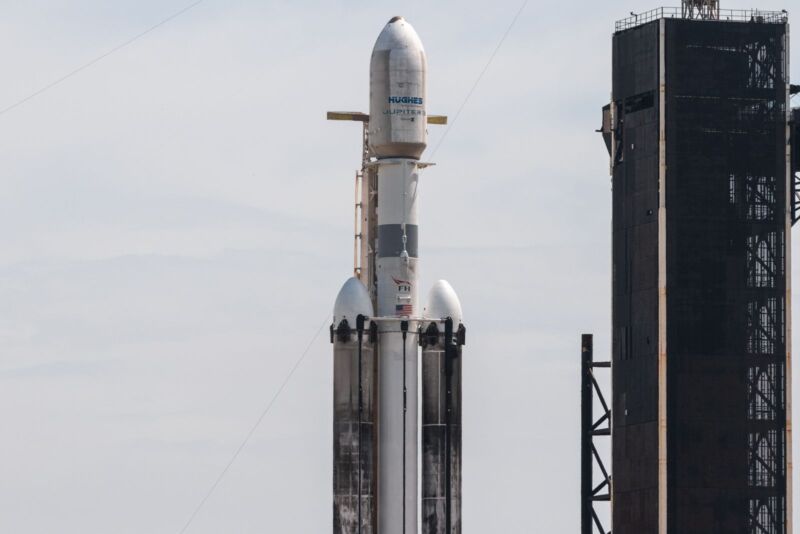
12:30 a.m. EDT Thursday update: SpaceX has scrubbed the Falcon Heavy rocket’s first launch attempt and will try again Thursday night.
The heaviest commercial communications satellite ever built is folded up on top of a SpaceX Falcon Heavy rocket for launch as soon as Thursday night from NASA’s Kennedy Space Center in Florida.
This satellite, owned by EchoStar and built by Maxar, tips the scales at about 9.2 metric tons, or more than 20,000 pounds. SpaceX’s Falcon Heavy will propel the spacecraft on its way toward an operating position in geostationary orbit more than 22,000 miles (nearly 36,000 kilometers) over the equator.
SpaceX scrubbed the launch attempt Wednesday night with about a minute left in the countdown due to a “violation of abort criteria.” Teams in Florida are now setting up for another countdown Thursday night.
The action will begin at 11:04 p.m. EDT (03:04 UTC) with the ignition of the Falcon Heavy’s 27 main engines on Launch Complex 39A. A few moments later, the Falcon Heavy will climb away from its launch pad and head downrange toward the east from the Kennedy Space Center. You can watch SpaceX’s live webcast below.
EchoStar’s subsidiary Hughes Network Systems will put the satellite, named Jupiter 3, into service to provide Internet across the Americas, from Canada to Argentina.
Jupiter 3 will take the crown as the heavyweight champion of commercial communications satellites. It’s at least a couple of tons heavier than any satellite of its kind that has launched before. The spacecraft is also the most massive payload ever lofted by a Falcon Heavy, still the world’s most powerful commercial launch vehicle in operational service.
“It is large,” said Mark Wymer, a senior vice president at Hughes Network Systems. “The satellite from tip to tip is about 10 stories, so it’s a monster. It’s weighing in right around 9 (metric) tons, which is why we need the SpaceX Falcon Heavy to get it up into space. What drives a lot of the size and scale of that is we know that there’s this huge hunger for data, and we knew that we had to put a good bit of bandwidth up in the sky.”
The Jupiter 3 satellite, sometimes called EchoStar 24, will provide up to 500 gigabits per second of total capacity, beaming Internet signals to rural homes, businesses, airplane passengers, and government and military users.
“When you think about what it takes to support a 500-gigabit throughput satellite, in terms of the power and the solar arrays, and so forth, that’s what drives its size, scale, and scope,” Wymer told Ars in an interview before Wednesday night’s launch.
These are the kinds of missions that suit SpaceX’s Falcon Heavy. Such a heavy satellite could not launch into the same orbit on a Falcon 9 rocket, even if SpaceX expended the first stage. The Falcon Heavy combines three Falcon 9 boosters together to triple the rocket’s power at liftoff.
On Thursday night’s mission, SpaceX will return the two side boosters to landings back at Cape Canaveral Space Force Station in Florida, a few miles south of the Falcon Heavy’s launch pad. The center core booster will burn through all its liquid propellant to give its payload as much speed as possible before shutting off and re-entering the atmosphere to crash into the Atlantic Ocean.
The twin side boosters, both reused from previous missions, will detach from the core stage around two-and-a-half minutes after liftoff. Those boosters will flip around to fly tail-first, then reignite their engines to reverse course and head back toward the Florida coast. Descending vertically, the side boosters will return to their landing zones just shy of eight minutes into the mission, accompanied by the sharp clap of sonic booms.
The unique choreography of a Falcon Heavy launch—with three rockets in controlled flight simultaneously—is becoming a familiar sight on Florida’s Space Coast. This will be SpaceX’s seventh Falcon Heavy launch and the third of five planned this year. It’ll be SpaceX’s 50th Falcon rocket launch in 2023—or 51st launch if you count the test flight of the Starship mega-rocket from Texas in April.
https://arstechnica.com/?p=1956756

